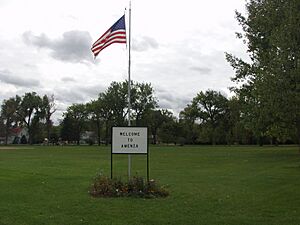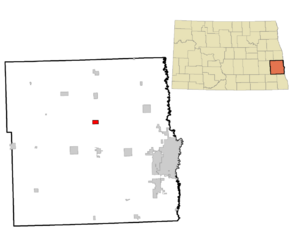Amenia, North Dakota facts for kids
Quick facts for kids
Amenia, North Dakota
|
|
|---|---|

Amenia, North Dakota
|
|

Location of Amenia, North Dakota
|
|
| Country | United States |
| State | North Dakota |
| County | Cass |
| Founded | 1880 |
| Area | |
| • Total | 1.49 sq mi (3.86 km2) |
| • Land | 1.49 sq mi (3.86 km2) |
| • Water | 0.00 sq mi (0.00 km2) |
| Elevation | 958 ft (292 m) |
| Population
(2020)
|
|
| • Total | 85 |
| • Estimate
(2022)
|
85 |
| • Density | 57.09/sq mi (22.04/km2) |
| Time zone | UTC-6 (Central (CST)) |
| • Summer (DST) | UTC-5 (CDT) |
| ZIP code |
58004
|
| Area code(s) | 701 |
| FIPS code | 38-01940 |
| GNIS feature ID | 1035908 |
Amenia is a small city in Cass County, North Dakota, United States. It was founded in 1880. In 2020, about 85 people lived there.
Amenia is known for having several tall towers. These towers send out signals for TV and radio stations from nearby Fargo. A former governor of North Dakota, William L. Guy, lived in Amenia before and after his time in office.
Contents
History of Amenia
The town of Amenia started because of a group of rich investors. These investors were from places like Amenia, New York, and Sharon, Connecticut. In 1875, they formed a company called the Amenia and Sharon Land Company.
Buying the Land
The company bought a huge amount of land, about 27,832 acres, from a railroad company that was having money problems. At first, the investors wanted to prepare the land and sell it quickly to new settlers. They hoped to make money fast.
Starting a Farm Town
However, they saw how well a very large farm, called a "bonanza farm," was doing nearby. These farms were huge and grew a lot of crops. The soil in Amenia was also very good. So, the investors decided to keep the land. They started to clear the land to grow wheat.
Growth of the Village
To help move their wheat to market, the company built a train station and a grain elevator in 1881. A grain elevator is a tall building used to store grain. Around these buildings, the village of Amenia began to grow. By the mid-1880s, the town had enough people to need a school. They also built a church.
Geography and Climate
Amenia is a small place. According to the United States Census Bureau, the city covers about 1.43 square miles (3.7 square kilometers). All of this area is land.
Weather in Amenia
Amenia has a type of weather called a humid continental climate. This means it has big changes in temperature during the year. Summers are warm to hot, and often humid. Winters are cold, and sometimes very cold.
People of Amenia
The number of people living in Amenia has changed over the years.
| Historical population | |||
|---|---|---|---|
| Census | Pop. | %± | |
| 1930 | 90 | — | |
| 1940 | 104 | 15.6% | |
| 1950 | 127 | 22.1% | |
| 1960 | 117 | −7.9% | |
| 1970 | 80 | −31.6% | |
| 1980 | 93 | 16.3% | |
| 1990 | 82 | −11.8% | |
| 2000 | 89 | 8.5% | |
| 2010 | 94 | 5.6% | |
| 2020 | 85 | −9.6% | |
| 2022 (est.) | 85 | −9.6% | |
| U.S. Decennial Census 2020 Census |
|||
Life in 2010
In 2010, there were 94 people living in Amenia. These people lived in 34 homes, and 31 of these were families. Most people in Amenia were White (92.6%). A small number were Native American (3.2%) or from two or more races (4.3%).
Many homes (38.2%) had children under 18 living there. Most homes (88.2%) were married couples living together. The average home had about 2.76 people. The average family had about 2.90 people.
The average age of people in Amenia was 35.3 years old. About 26.6% of residents were under 18. About 8.5% were 65 or older. The city had slightly more females (51.1%) than males (48.9%).
See also
 In Spanish: Amenia (Dakota del Norte) para niños
In Spanish: Amenia (Dakota del Norte) para niños

